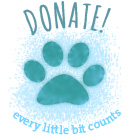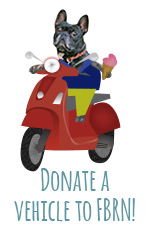Mast Cell Cancer and Frenchies
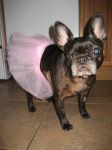 Mast cells have a beneficial purpose in dogs. They attack parasites by releasing enzymes and histamines (the same chemical that can cause hives and itching) and are part of a dog's immune arsenal. When a mast cell detects a parasite, it ruptures, releasing an explosion of histamines and enzymes to destroy the parasite and to signal to other mast cells to respond.
Mast cells have a beneficial purpose in dogs. They attack parasites by releasing enzymes and histamines (the same chemical that can cause hives and itching) and are part of a dog's immune arsenal. When a mast cell detects a parasite, it ruptures, releasing an explosion of histamines and enzymes to destroy the parasite and to signal to other mast cells to respond.
Mast cell cancer is very common in brachycephalic dogs like Frenchies, Boston Terriers, Pugs, and especially Boxers. Vets are very aware of the high rate of mast cell cancer in our dogs and when they see a lump or bump, they will take a few cells and see what the bump is made of. We have had many foster dogs in our care with mast cell tumors, and we have been very lucky to find that nearly all of the tumors have been caught early.
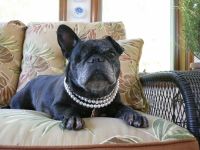 This week we took in a dog with a mast cell tumor on his penis. His owner noticed the lump two years ago and pointed it out to her vet at a local low-cost national chain of veterinary clinics. His opinion was that the lump was a deformity. He was wrong about that, and the tumor continued to grow over the next two years. You can see a photo of the tumor on Pipsqueak's foster page or on the blog.
This week we took in a dog with a mast cell tumor on his penis. His owner noticed the lump two years ago and pointed it out to her vet at a local low-cost national chain of veterinary clinics. His opinion was that the lump was a deformity. He was wrong about that, and the tumor continued to grow over the next two years. You can see a photo of the tumor on Pipsqueak's foster page or on the blog.
We are concerned that so many dogs in our care--more than a dozen in the past year alone--have come to us with mast cell tumors. Owners either didn't notice them or were told to watch and wait. Mast cell tumors also have the peculiar habit of growing and then diminishing, as the mast cells are irritated and grow larger and then release their histamines and enzymes are grow smaller. Many owners may find a lump one day, then check again the next day only to find that the lump is less pronounced, so they are relieved.
If your Frenchie has a lump or bump on the surface of his skin, especially in the genital region, NEVER wait and see. Take your dog to the vet asap, and ask for a needle aspiration. If it's cancer, waiting will only allow the tumor to grow.
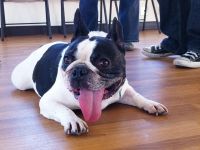
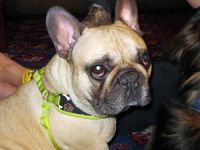
There is good news and bad news regarding mast cell tumors in dogs. Most mast cell tumors are successfully removed and require no further treatment, though a dog with a mast cell tumor may spring another one, so owners must be aware and on the lookout. But in most cases, when you remove the tumor, you remove the problem.
Sometimes mast cell tumors are more dangerous or they appear in hard-to-remove places--paws, for instance--and additional treatment like radiation may be required.
There are 5 stages and 3 grades of mast cell tumors.
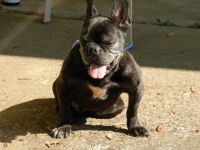 Tumors are "graded" to indicate how malignant the tumor might be. When people talk about cancer surgery, they will often say, "The tumor was removed, and the surgeon was able to get clean margins." What that means is the tumor was completely removed, and the surgeon was able to take out the entire growth with about an inch of tissue all the way around the growth. This is the best news you can get in terms of tumor removal.
Tumors are "graded" to indicate how malignant the tumor might be. When people talk about cancer surgery, they will often say, "The tumor was removed, and the surgeon was able to get clean margins." What that means is the tumor was completely removed, and the surgeon was able to take out the entire growth with about an inch of tissue all the way around the growth. This is the best news you can get in terms of tumor removal.
A grade 1 tumor indicates that though the tumor might be large, it is considered benign, and the dog goes on to live a long and happy life. These tumors don't usually spread. Most mast cell cancers are grade 1.
A grade 2 tumor indicates that there is some spread to tissue below the skin's surface and the cancer is more difficult to remove. Though often treated successfully, these tumors can have a more unpredictable outcome and may require different treatments.
A grade 3 tumor is likely to be aggressive and require more complicated treatment.
There are 5 stages of tumors, from 0 to 4, and these degrees mark whether the tumor has spread throughout the body. A stage of zero means there has been no spread.
If your dog undergoes surgery for mast cell tumors, be sure to get both the grade and the stage of his cancer, so you can know what you are dealing with. Owning a Frenchie or other brachycephalic breed means you must be especially aware of your dog's skin. Mast cell tumors can appear anywhere, but are most often seen on the trunk, legs and genital region. A yearly exam at your vet's office is a very good idea, but if you find a lump or bump, make an appointment to have your Frenchie seen as soon as you can.
Owning a Frenchie or other brachycephalic breed means you must be especially aware of your dog's skin. Mast cell tumors can appear anywhere, but are most often seen on the trunk, legs and genital region. A yearly exam at your vet's office is a very good idea, but if you find a lump or bump, make an appointment to have your Frenchie seen as soon as you can.
For more information on mast cell tumors, Google "Mast Cell cancers in canines." Information here was found at the following links:
WSU Vet Hosputal: Canine Mast Cell Tumors
PetEducation.com: Mast Cell Tumors
Vet Surgery Central: Mast Cell Tumors in Dogs and Cats
The photos on this page are of FBRN dogs, both current and grads, who are survivors of mast cell cancers: Crimson, Kermit, Lilac, Magnolia, Maxwell Smart, and Teeny!



